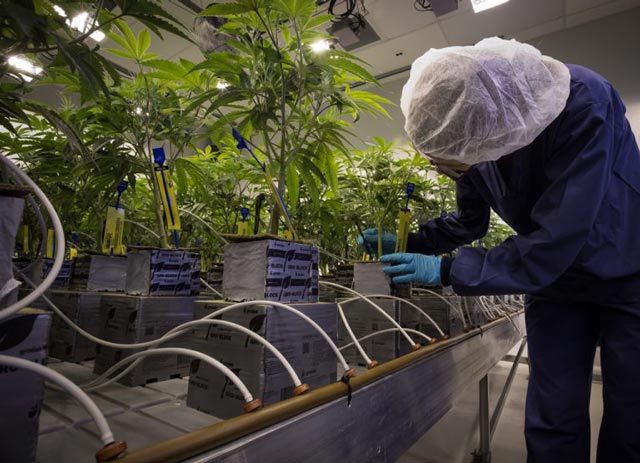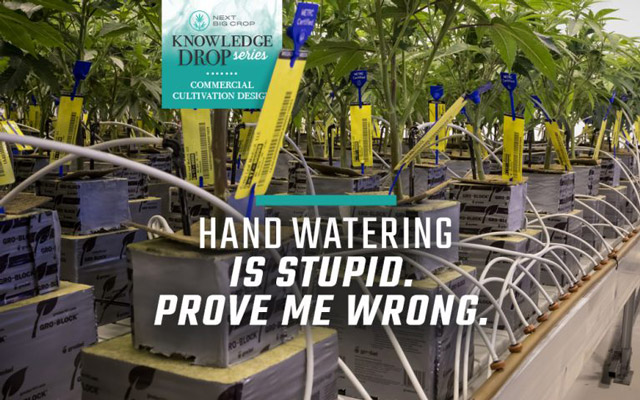By Aaron Mullins – Systems Coordinator, Next Big Crop
Water. Agua. H2O.
It’s one of the most fundamental aspects of any cultivation operation. But just because it’s a basic building block doesn’t mean you should approach it with a basic mentality.
Because properly watering your plants is so vital to your success and this task is performed with such frequency, automated irrigation systems for cultivation facilities are now a requisite for commercial growers in today’s hyper competitive wholesale environment and shrinking profit margins.
When you factor in the widespread impact of the pandemic on consumer shopping habits, the need for growers to maximize their production capacity amid the consumer-driven shift toward lower-priced “value” products has never been more urgent.
You might be able to get away with hand watering your plants up to a certain point. But the cost-benefit analysis of implementing an automated irrigation system is crystal clear when it comes to operational efficiency and reduced labor costs.
Crop Yield and Quality
Consistent crop yields are central to any successful growing operation, but humans have an unfortunate tendency to be anything but consistent.
Proper watering techniques require practice and skill to manually deliver the appropriate amounts of water to the plant, in addition to properly timing those watering cycles.
When a cultivation technician is making the rounds and watering by hand, they’re manually pumping the water and counting the seconds in their head for how much water each plant receives. Obviously, this is not a very scientific method, and everyone counts a little differently. And are the plants toward the back of the room receiving the same level of attention as the front of the room? Uneven watering quickly leads to plants of varying sizes.
In large-scale production, when there’s a lot of inconsistency in the canopy, the yields won’t match projected targets and budgeting becomes much more difficult than it has to be.
So take the human error out of the equation.

An automatic watering system for indoor grows becomes a key differentiator because an experienced cultivation manager ensures plants are maintained according to their methodology and can easily monitor the progress of plants throughout the production cycle.
The cultivation manager establishes the watering program schedule, which can be configured for each growing room. For example, using half-gallon per hour emitters makes it easy to specify the amount of water going to the plants. Sensors monitor how much water and nutrients plants are receiving, and adjustments can be made as plants grow larger and their requirements change as they fill in their containers.
These nuanced adjustments simply aren’t achievable with hand watering.
Labor Efficiency and Waste Reduction
Beyond the consistency that an automated watering system for an indoor grow can deliver, there are plenty of cost savings to be had with reduced labor and more efficient use of resources.
Setting up rooms with automated watering greatly reduces the labor needed for daily plant care, so employees can be utilized more strategically in hands-on areas such as propagation, transplanting and processing.
Automated irrigation systems for cultivation facilities also can be monitored remotely, which means cultivation managers can keep an eye on multiple facilities at once. They can also make adjustments on the fly based on individual zone watering needs while managing the entire cycle of the crop.
An added cost-savings benefit comes from the environmentally friendly ability to catch and reuse water, also known as a zero-runoff system. This in turn reduces the costs of treated water and nutrients.
A zero-runoff system is also super important in localities with strict water-use restrictions, especially near watershed zones. This water-wise approach also benefits companies whose brands are built on a platform of sustainability.
Maintaining an Indoor Grow Room Watering System
In the long term, automating always outperforms hand watering—as long as the system is maintained to avoid growth of algae and bacteria in the lines. It’s important to remember that these systems can do a lot of things, but they can’t fully clean themselves.
However, this routine care can easily be performed—no special knack for cultivation required—and the need to replace parts is minimal. The cultivation crew should do weekly checks on emitters, and monthly checks on sensors to ensure they’re calibrated according to the growth phase.
A deep clean on the system can be performed on harvest day as part of the takedown and preparation for the new production cycle. You can run cleaning products through the system and an acid solution through the emitters to keep them flowing consistently. We advise replacing the emitters once a year if there’s hard water or salt-heavy nutrients in use.
Compared to the labor needed for hand watering, irrigation system maintenance takes a fraction of the time.
All together, the ability of an automated irrigation system to generate consistent crops and streamline daily plant care means your profits won’t get watered down.
Learn more about Next Big Crop’s systems integration services.

